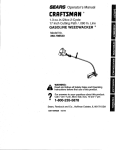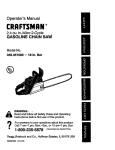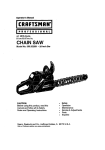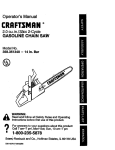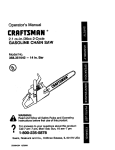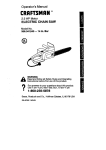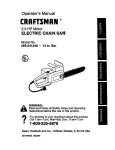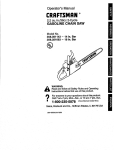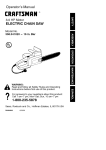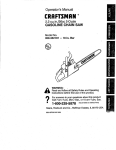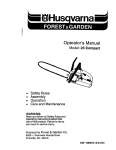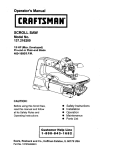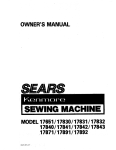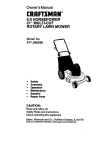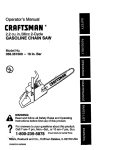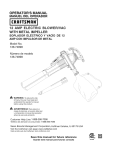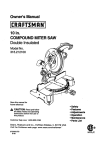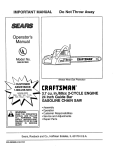Download Craftsman 358.341140 Operator`s manual
Transcript
Operator's Manual CRRFTSMR.N 2.5 HP Motor ELECTRIC CHAIN SAW Model No. 358.341140 - 16 in. Bar ® Read and followall Safety Rules and Operating WARNING: Instructionsbefore first use of this product. "illl_ ir • For answers to your quest!ons about this product: Call 7 am--7 pm, Mon--Sat, Sun, 10 am-7 pm 1-800-235-5878 Seam_oebuck 530-087666 0_17R8 and Co., Hoffman Estates, IL 60179 USA Warranty Safety Rules Assembly Operation Maintenance-_ 2 2 7 7 12 Service and Adjustments Storage . Trouble Shooting Spanish Parts Ordering 13 15 15 18 Back This v_arrdnb, . r and chain, which are expendable parts and become worn'during hormal use. If this Craftsman Electric Chain Saw is used for commemial purposes, this warran_ app.lies for only 90 days from the date of purchase. If this CraftsmanElectncChain Saw is usedfor rentalpurposes,thinwarranty appliesfor only30 daysfrom thedate of purchase.This warrantyappliesonlywhilethisproductis in use in the UnitedStates. WARRANTY SERVICE IS AVAILABLE BY RETURNING THE CRAFTSMAN ELECTRIC CHAIN SAW TO THE NEAREST SEARS SERVICE CENTER IN THE UNITED STATES. This warranty gives you specific legal rights, and you may also have other rights which vary from state to state. Roebuck and Inc,, Hoffmen Estates 60179 U.S.A. WARNING: When using an electric chain saw, basic safety precautions, including the following, should always be followed to reduce the risk of fire, electric shock, and injuryto persons. Read all instructions. WARNING: Always disconnectpower sourcewhen maldngrepairs.Becausea chainsaw is a high-speedwoodcutting tool,carelessor improperusa of thistool -_=can cause seriousinjury. PLAN AHEAD proved safety hard hat; and sound barriers (ear plugs or mufflers) to protect your hearing. Regular users should have hearing checked regularly as chain saw noise can damage hearing. Clothing Gloves • Restricttheuss'ofyeurssw to adult userswhoundemtand andcanfollow the saf_y rules, precautions, and oper- a_ng i_ found _ _s marn_ • Keep chgdrenaway. Do notlet vidtom contsctchslnsaw or extermicncord.All visitorsshouldbe I=pt at least30 feet Safety Shoes "_ f Safety Chaps NI • Secure hair above shoulderlength.Do not wear Ioo_...clothin_or jew.d_ they , * Dress properly. Wear protective gear. .cccccccc_n get caught,n mov,_..garB. . AIw.. ays use steel-toed safety footwear _eep all parts of your ocoy away rmm with non-slipsoles; snug-rdtingcloththe chain when saw is running. Do not handleor operatea _ saw ing, heavy-duty, non-slip gloves; eye F¢otection such as non-fogging, when you am fatigued, ill,upset,orif you have taken alcohol,drugs,or mevented goggles or face screen; an ap- (lO mste_)aweyfrornworkarea dication.Youmust be in good physical cor_rdion.andmentallyalerL ff you have any concFdonthat mightbe aggravated by strenuouswork, check with doctor before operating. Watch what you are doing. Use commonsense. _ ::.... • Do not start cutting until you have a " clear work area, secure footing, and especially if you are felling a tree, a retreat path. Keep work area clean. Cluttered areas invite injudas. OPERATE YOUR SAW SAFELY • Do not operate with one hand. Sedous injuryto the operator, helpers, or bystanders may result from onehanded operation. A chain saw is intended for two-handed use. • Do not operate saw from a ladder or in a tree. • Make sure the chain will not make contact with any object while starting the saw. Never start the saw when the guide bar is in a cut• • Don't force chain saw. It will do the job better and safer at the rate for which it was intended. • Do not put pressure on the saw, especially at the end of the cut. Doing so can cause you to lose control when the cut is completed. • Stop the saw before setting it down. Hand carry sew only when motor is stopped. Carrythe chainsaw by the fronthandlewiththe saw sty, fmgor offtbe switck _le guide bar and saw chainto the rear. • Use the righttool, cut wood only. Don't use chain saw for purpose not intended;for example, don't usa chain saw for cutting plastic, masonry, non-wood buildin_ rnstedals. • Usa extreme caution when cuffing • small's_ brush and saplings because the tender matedal m.ay catch the saw chain and be wh-ipp_l toward - you or pull you off balance. • When cuttinga limb that is under tension be alert for epnng back so you will not be struckwhen the tension in the wood fibers is released. MAINTAIN YOUR SAW IN GOOD WORKING ORDER • Have all chain saw service performed _ya Sears Service Center except the listed in the maintenance saction of this manual. • • Ma_e-_ef_dn saw chain stops moving when trigger switch is released. and grease. i free Keepfrom the oil handles dry and clean and Keep oil cap andfastenere securely tightened. • • N-onco orming re _cament corrconants ortbe removalof safety devices may osuse damage to tha unitand _sta_eminjuw to the operatoror by• Usa only Craftsmanaccassodes and replacementparis as r_ommended. Never modi_,yoursaw. • Maintain chain saw with care. i Keep and safer unitsharp performance. and clean for better Follow instructionsfor lubricatingand changing accessodee. • Unplug the chainsaw fromthe power source when not in use, before servicing, and when changing accessories and attachments, such as saw chain and guard, • Check for damaged parts. Before further use of the chain saw, a guard or other part that is damaged should be carefully checked to determine that it will operate properly and perform its intended function. Check for alignment of moving parts, binding of moving paris, breakage of pads, mounting and any other conditions that may affect its operation. A guard or other part that is damaged should be properly repaired or replaced by a Sears Service Center unless otherwise indicated elsewhere in the operator's manual. • Do not operate a chain saw that is damaged, improperly adjusted, or is not completely and securely assembled. Inspect chain saw cords periodically, and if damaged have re- paired by a Sears Service Center. • When not in use, chain saws should be stored in a dry, high or locked-up place out of the reach of children. • When storingsaw, unplug and use a bar sheath or carrying case. Store idle chain saw. ELECTRICAL SAFETY • Use a voltagesupply as shown on unit • Avoid dangerous environments. Don't usa appliances in damp or wet locations. Don't use in rain. • Avoid dengemus situations.Do not use in the presence of flammable liquids or gases to avoid creating a fire or explosion and/or causing damage to unit. * To reducethe risk of aiectrical shock, this appliancehas a polarizedplug (one blade is wider than the other)and will requirethe use of a polarizedextensioncord.The applianceplugwl]lfit intoa polarizedextension cord ordy one way. If the plugdoes notlit fully intothe ex_ion cord,.mversethe pbg. the saw cords pedodioallyand if damaged, have repaired by a Sears Service Center. GUARD AGAINST KICKBACK Fonow aasafety ruk te.h p.avoUk k- back and otherforcaswhichcan rasultin serious" " qury. Kickback Path doesnotfit,obt a correctpolarized extensioncord. A polarizedextensioncord will requirethe of a polarizedwell outlet.This plug w_llfit intothe polarizedwail outistonly one way. If plug does not fit fullyinte the wail outlet,reveme the plug. ffthe _ectridanSbll does not _ contacta qualified to installthe proper wall outlet. Do not changethe equipmentplug, extensioncord receptacle,or extension cord plug _ any way. . • To reduce nsk of electricalshock, use extensioncordsspecltk_dly_ as suitablefor outdoorappliancesha_ng electricalratingnot lessthan the rating of unit.Cord must be markedwithsuffix "V_. Make sure your extensioncord is in good condition.Inspectextension cord before use and replace ifdamaged. An undersizedextensioncord will cause a drop in linevoltageresulting in lossof power and overheating.If in doubt,use the next heavier gauge. The lowerthe gauge number,the heavierthe cord (see =Selectan extension cord'). • Do not abuse cord. Never carry the unit by the extension cord or yank extension cord to disconnect unit. • Secure extension cord to power cord to prevent disconnectionfrom unit. • Do not use the unit if the switch does not turn the unit on and off properly,or if the lockout does not work. Repairs to the switch must be made by a _--Sears Service Center. • Keep extension cord clear of operator and obstacles-at all times. Position cord so that it will not be caught on brancbas. Do not expose cords to heat, oil, water, or s...ha., rp edges. * To avo=dthe poss=bdityof electric shock, avoid body contact with any grounded conductor, such as metal fences or pipes. . • Ground Fault Circuit Interrupter (GFCI) protection should be provided on circuitor outletto be used. Receptacles are available having built-in -GFCI protection and may be used for this measure of safety. Inspect chain • Clear The WorldngArea WARNING: Rotational Kickback can occurwhen the moving chain contacts an object,at the upper portionof the tip of the guide bar. Contact at the upper portion of the tip of the guide bar .can cause the chain to dig intothe object, which stops the chain for an instant. The resultis a lightningfast, reverse reaction which kicksthe guide bar up and back toward the operator. Pinch-Kickbackand Pull-In occur when the chain is suddenly stopped by being pinched, caught, or by contacting a foreign object in the wood. This sudden stoppingof the chain resultsin a reversal of the chain force used to cut wood and causes the saw to move in the opposite directionof the chain rotation. Pinch-Kickbackdrives the saw straight back toward the operator. Pull-In pulls the saw away from the operator. KICKBACK WARNING: IOckbackcan occur whan the moving _ contacts.an objectat the upper porSonof the Upof the guidebar orwhen the..w_:l, doses in and p_ches the saw cl_in in the cut. The _xnputed }Ockbeck Angle(CKA) rmtedon yoursaw and rm_d in the followingCKA Tablerepresentsthe angleof Idckbackyour bar and chain cord_ will have wi'_n tested io acosrdancewith CSA and ANSI standard= Computod ang mp. od the CKA cokrnn indicate tetai anergy and angleassociatedWl_'_uta cbainbrako. purches rep g osmo consU- erationsshouldbe givento the lower CKA values. In all cese_ lower CKA vak 4 ues represent a safer operating environCKA requirements per standard. merit for the user. REDUCE THE CHANCE OF Do not rely exclusively upon the safety KICKBACK devices built into your saw. The following presauliom dlould be fal• Either of these reactions may cause lowed to minimize Idckback: you to lose control of the saw which . • Grip saw firmly. Hold chain saw finnly coul.d result in sedous, ih_lry. -".... withbothhandswhenmotorisrunning. • _,incning the saw cnaJn along the tip Usa a firm grip with thumbs and fingers * of the guide bar may push the guide encircling chain saw handles. bar rapidly back toward the operator. • Do not over reach. -, "lip cohtact in some cases may cause • Keep proper footing and baiance at a lightning fast REACTION, kicking the all times. guide bar up and bsck toward operator. • Don't let the nose of the guide bar CKA TABLE contact a log, branch, ground or other obstruction. BAR CHAIN MODEL P/N 358341140 71-36366 _ P/N 16" 71-36_1 CK/= 2_' CHAIN BRAK]E & CKA ANGLE WARNING: The effectiveness of a chain brake in reducing operator injuries has not yetbeen fully determined. We cannot represent that a chain brske is an effective safe_ device to preventor reduce the hazard of injurias resulting from kJc_ DO NOT ASSUME THAT THE CHAIN BRAKE WILL PROTECT YOU IN THE EVENT OF A KICKBACK..Instead, use the saw properly and carefully to avoid Idckback. Reduced KT_kback bars and Low l_]ddoack chainsreducethe hazard of Idcld:_ck and are recommended. Repairs on a chain brake should be roads by a Sears Service Center. Take your unit to theplaceofpurchaesif purchesed from a Servicing Center, or to the nearest SearsServiceCenter. WARNING: Computed kickback angle (CKA) listsd on your saw and rstsd in the CKAtabis represents _ of yourbar _d d'minocrabinatkmswUl havewhen teetedin_xx_:lancewiLh CSA ar_SI standards. When pur. chasing rel_ceme_barandch_r_coosiders_ons should begivan Tott_elower CKAvalues.LowerCKAvaluesrepresentsafer ang|es totheuser, .hig.her ." _- Don't cut above shoulder height. Use devices such as low Id_ck chain, guide bar nose guards, chain brakes, and special guide bars that reduce the risks associated with kickback. • Only use replacement bars and chains specified by the manufacturer or the equivalent. Avoid Pinoh-Kickback: • Be extremely aware of situations or obstructions that can cause material to pinch the top of or otherwise stop the chain. • Do logat Do not not cutmore twist the thanone saw as the bar aistime. withdrawn from an undercut when bucking. Avoid Putl-ln: • Always begin cutting with the saw at full speed and the saw housing againstwood. • Usewedgesmadeof plasticorwood. Never use metal to holdthe cut open. MAINTAIN CONTROL: The following precautionsshould be followed to minimize Idckback. • A good, firm grip on the saw with both hands will help you maintaincontrol. Don't let go. Grip the rear handle with your right hand whether you are right or left handed. uas"_r_te..moroangleandhigherkick . enengles. In all cases lower CKA valuss _,ant a sa_ opera_ an_onmant for the user. The guide bar and chain combination(s) shown in the CKA Table meet kickback requirements of CSA Z62.1, Z62.3, & ANSI B175.1 when used on saw(s) Ibtod in this manual. Usa of barand chain combinaflor_o"ther than those listed is not recommended and may not meet the • Wrap the fingers of your left hand over and around the front handlebar, and your left thumb under the front handlebar. • Low Kickback Chain has met kickback performance requirements when tested on the representative sample of these chain saws specified in ANSI B175.1. LowKickbackChain • Whenmakingbuckingor pruning cuts,positiohi_/our left h_mdonth.e fronthandlebarso it is ona stnught line with your righthand on the roar handle. Stand slightlyto the left side of the saw to keep your body from being in a direct line with the cutti'ng . chain. Keep your left arm straight with the elbow locked. • Stand with your weight evenly balanced on both feet. • Do not overrsash. You couldbe drawn or thrownoff balance and lose control. • Do not cut above shoulder height. It is difficultto maintain control of saw • ,_..P---_, _ _=_ Contoured Depth Gauge Elongated Guard Unk Deflects Iqcld3ackForce And Allows Wood To Gradually Ride Into Cutter SAFETY NOTICE: F.xposurato vibrationsthrough prolonged use of hand tools could cause blood vessel or nerve .damagein the fingers, hands, and j0untsof people prone to circulation disoiders orabnormal swelling. Prolonged use in cold weather has been Innkedto blood vessel damage in otherwise healthy people. If symptoms occur such as numbn.ess,pain, loss of aboveshoulderheight. strength, change m skin color or KICKBACK SAFETY FEATURES texture, or lossof feeling in the fingers, WARNING: The followingfeatures are hands, or joints, discontinuethe use of this tool and seek medical attention. An includedon your saw to help reduce hazard of kickback; however, such fee- anti-vibration system does not guarantee the avoidance of these turns will not totally eliminate this danger. Do not rely only on safety devices. problems. Users who operate power tools on a continual and regular basis • Handguard: designed to reduce the must closely monitor their physical chance of your left hand contacting condition and the condition of this tool. the chain if your hand slips off the DOUBLE INSULATION front handlebar. • Positionof front and rear handlebars: CONSTRUCTION designed with distance between han- This unitis DoubleInsulatedto help prodles and "in-line"with each other. The tectagainstelecl_ shock.Double insulation_ consistsof two sspemte spread and "in-line"positionof the =layers" of electrical insula6oninsteadof hands provided by this design work together to give balance and resis_" "withthis insulationsystemars tance in controllingthe pivot of the notIntendedto ba grounded.No groundsaw back toward the operator if kickingmeans is providedon this unit,nor back occurs. shoulda meansof grounding be added • Reduced-Kickback Guide Bar. detothle untL signed with a small radius tip which seduces the size of the kickback dan- Safetyprecautionsmustbe observed when operaiingany electricaltcol.The ger zone. This type bar has been deuceuU!on r ovk . demonstrated to significantlyreduce the number and sedousness of kickbacks when tested in accordance failure. with ANSI B175.1. STANDARDS: This product is listed by Underwriters Laboratodos, Inc. in acSmall Radius cordar_e with UL Standard 1662 and Tip Guide Bar CSA Standards Z62.1 and Z62.3 and ANSI B175.1. SAVE THESE INSTRUCTIONS - CARTON CONTENTS Models358.341140 ChainSaw(fullyassembled) " BarShsath _ ........ partsmissingor damaged,pleasecall 1-800-235-5878 ASSEMBLY Examine parts for damage. Do not use damaged parts. NOTE: If you need assistance or find Your saw ts fully assamblad; no . assembly is necessary. KNOW YOUR SAW READ THIS OPERATOR'S MANUAL AND SAFETY RULES BEFORE OPERATING YOUR CHAIN SAW. Compare the Illustrationswith your unit to farnlliadze yourself with the location of the various controlsend adjustments. Save this manual for future reference. OiLerActuator/ Bar Oil Cap Chain AdjustmentScrew Lockout B_ton Chain Tdggar Switch Recessed Plug TRIGGER SWITCH The trigger switch is used to tum on the unit. Squeeze the trigger switch to operate the unit after lockoutbutton has RECESSED PLUG The recessed plug is used to connect the saw to an approved extension cord. CHAIN TENSION It is normal for a new chain to stretch tumbeenthePUShedunit off.in" Release the trigger to duringfirst 30 minutes of ope.rat_n. You LOCKOU:r-BU'rTON should check your chain tensnonfreThe Lockout Buttonis a control feature quently. Readjust chain after every 15 designed to prevent the metor_-fi'om be- minutes of operation.See Chain Tening accidenUy stadad. When the rear sion under the Service end Adjusthandle is gdpped in a normal cutting ments section. position,the lockout button can be OPERATING INSTRUCTIONS pushed in by the thumb, permitting the Use onlya vobagesupplyas specified nndexfinger to squeeze .thetrigger. It is on your unit. not necessaW to maintain pressure on Extensioncords are avallabisfor this unit. the lockoutbutton once the trigger has Secureextonsioncordto powercordto been engaged. . prevent_ fromunit. BAR OIL CAP/OILER ACTUATOR The oil cap is used to access the bar oil tank end pressed to supply oil to chain. CHAIN ADJUSTMENT SCREW The chain adjustment screw is used to adjust the chain tension. _ _ _ _ I11 SELECT AN EXTENSION CORD MINIMUM WIRE GAUGE RECOMMENDATIONS Volts I100ft. orless 120 14 o A.W.G. I 100ft.tot50ft. I 12 A.W.G.* "Americln WI_ GwJge BEFORE STA_ITING S_.W WARNING: Be sure to read the electrical safety information in the safety rules section of this manual before you begin. If you do not understandthe electrical safety Informationdo not attempt to use your uniL Seek help from someone that does understand the informationor call the customer assistanca help line at 1-800-235-5878. GUIDE BAR AND CHAIN OIL The manuallyoperatedchaln,oilerpmvtdeslubrica_onto the chainand guide Imr. Be sum to fillthe bin"o_ltankbofom ead_ cuttingsession.Tim oilero_liv'ator/ bar o, cap mus_be um_l n_julmlyand oftenenoughto maintaina thin_Im of on on tha bar and chainwh_ sew Is cutting. It is recommended that the o_r actuator/ bar oil cap be operatedsix (6) times per minute and heldfor appro_matelythree (3) secondseach time it is pressed. For maximumguide bar and chainI'Ve,we recommendyou use Craftsmanchain saw bar o_1.If Cral_rnan bar o=1is not available,you may use a goodgrade SAE 30 oil unblyou are able to obtain _man b.m_. The oiloutputis manuamymetered dunngoperation. Use a funnel to fillthe tank. Replaceoil cap securely. Checkoil level after every 15 minutesof operate. STOPPING YOUR SAW • Release the trigger switch. If motor does not stop, disconnectthe extension cord. STARTING YOUR SAW _Connect the saw to a power source using the proper__siz_ extension cord; see SELECT AN EXTENSION CORD. • Push in switch lock out button. • Squeeze and hold the tdgger switch. OPERATING TIPS • Check chain tension before first use and after I minute of operation. See Chain Tension in the Maintenance section and Service and Adjustment section. • Cut wood only. Do not cut metal, plastics, masonry, non-wood buildingmateriels, etc. • Stop the saw if the chain strikes a foreign object. Inspect the saw and repair parts es necessary. • Keep the chain out of dirt and sand. Even a small amount of dirtwill quickly dull a chain and mcresse the posel• bilityof kickback. Practice cuttinga few small logs using _ , the following steps. Thin will help you got the =feel" of using your saw before you begin a major sawing operation. • Squeeze the trigger switch and allow unitto rea.chfull speed before cutting. • Begin cutting with the saw frame against the log. • Kee..pthe motor at full speed the entire time _u are cutting. • Release trigger switch as soon as cut is comlpIsted, allowing motor to stop. • To avoid losingcontrolwhen out is complete, do not put pressure on saw at end of cut. • Stopmotorbeforesettingsaw down. TREE FELLING TECHNIQUES Checkfor brokenordead branches whichcanfall wh=lecuttingcausingseriousinjury.Do notcutnear b_'ldingsor electricelwirss ifyoudo notknowthe direct_ of treefall, norcutat nightsince youwillnotbe ableto see well, norduringbed wsathersuchas rain,snow, strongwinds,etc. Ifthe tres makes contactwith any _T_lyline, the ubqitycompla- ouldbe • _=_mfut_.planyour saw=ngoperationin • Clear the work area. You need a clear area all aroundthe tree so you can have securefooting. • Studythe naturalcondtJo_ that can cause the tree to fell in a parlJcular direction,suchas: • The wind directionand speed, • The lean ofthe tree.The lean of a tree might not be apparentdue to uneven orsloping terrain.Usa a plumborlevel to deten'ninethe directionof tree lean. • Weight and branches on one side. • Surroundingtrees and obstacles, • Look for decay and roL If the trunk is rotted,if can snap and fall toward the operator. • Make sure there is enough room for the tree to fall. Mamteln a distance of 2.1/2tree lengthsfrom the nearest person or other objects. Motor noise can drown out a wammg call. R • Remove dirt, stones, loose bark, nails, staples, and wire from the tree where cuts are to be made. higher than the horizontal notchingcut as illustrated.Keep the felling back cut parallel to the horizontal notchingcut. Make the felling back cut so enough wood is left to act as a hinge. The hinge Plan a clear retreat path wood helpsthe tree fromtwisting and falling in the wrong direction. Do not cut through the hinge. As the feel_g cutgets dose ot the hinge the tree shouldbeginto fall. If them .is any chancethat the tree may notfall in the desked cruectionorit may rockback A retreat path should be planned and and bind the saw chain, atop cuttingbecleared as necessary before cuts are started. The retreat path should extend fore the fellingbeck cutis complsteand wedges of wood, plasticor aluminum back and diagonally to the rear of the to open the cut and dropthe tree along e_-'ted rm of fall as illusl_ed abeve. the desiredline of fail. FELLING LARGE TREES Whon the tree bsgins to fall,remove the _6hinchesin diameter or larger) cheinsaw fromthe cut, stop the motor, e notch method ksused to fell large put the chainsaw down, then uss the retrees. A notch is cut on the side of the tree in the desired directionof fall. After treat path planned.Be alert for overhead limbsfallingand watchyour foo_ng. a felling cut is made on the opposite Hinge holds tree on stump and helps side of tree, the tree will tend to fall in control fall, the direction of the notch. . .... -,"- . ,- Y# NOTE: If tree has large buttress roots, remove them before making the notch. NOTCH CUT AND FELLING TREE • Make notch cut by cuffing the top of the notch first. Cut through 1/3 otthe diameter of the tree. Next complete the notch by cuffingthe bottom. See illustration.Once notch is cut, remove the wedge of wood from the tree. • After removingthe wood, make the felling cut on the opposite side of the • notch. This is done by making a cut about two inches higher than the center of the notch. Thkswill leave enough uncut wood between the felling cut and the notch to form a hinge. This hinge will help prevent the tree from falling in the wron direction. Final cut hem Opening of felling Closing of notch NOTE: Before felling cut is complete, use wedges to open the cut when necess.aryto controlthe direction of fall. To avoid kickback and chain damage, use wood or plastic wedges, but never steel or iron wedges. • Be alert to signs that the tree is ready to fall: crackingsounds,widening of the felling cut, or movement in the up- . per branches. As tree starts to fall, stop saw, put it down, and get away quicklyon your planned retreat path. • Be extremaly sautious with partially offal fallen trees that may be poorly supported. When a tree doesn't fall completaiy,set the saw aside and pull down the tree with a cable winch, block and taclde, or tractor.Do not Notching Undercut - Make the notch use your saw to cut down a partially 1/3 the diameter of the tree, perpendicfallen tree. ular to the direction of fall as illustrated. Make the lower horizontal notchingcut cUTrlNG A FALLEN TREE BUCmNG) fl..rs.L This will help to avoid pinching of uckmg m thetermusedforcutting a eithe.r,the saw chain or the guide bar fallen treetothedesiredlogsize. when tllrSecond notch is being made. Felling Back Cut - Make the felling WARNING: Do not stand on the log back cut at least 2 inches (50.Bmm) being cuL Any portion can roll causing "R_-cut| r, Notch "_[_. / o.lr / loss of footing and control. Do not stand downhill of the log being out. IMPORTANT POINTS ing in injury and/or damage to the saw. Stop the saw; drive a wedge of plastic or wood into cut until the saw can be • It is importantto make sure your footing removed easily. Restart saw and careis firm and your weight is evenlydistn'b- fully reenter the cut. Do not use a metal uted on both feet. When poss_e, the wedge, Do not attempt to restart your logshouldbe raised and suppodedby saw when it is pinched or hung in a log. Use a wedge to remove pinchedsaw • use of limba,__ogs, or blocks. • Cut only onelog at a time. Cut shattered wood very carefully;, sharp pieces of wood could be flung toward operator. • Use a sawhorse to cut small logs. Never allow another person to hold the log while cutting and never hold the log with your leg or foot. • Do notcut in an area where logs, androots aretan . Draglogs • • • • il_Oa dsarareab_Z_ cuing._. When "cuttingthrough', to maintain complete control, release the cuffing pressure near the end of the cut without looseningyour grip on the chain saw handles. Don't let the chain contact the ground. After completing the cut, wait for the saw chain to stop before you move the chain saw. Always stopthe motor before moving from tree to tree. __k Jl_ Tumsaw OFF andusea plasticor woodenwedgeto forcecutopen. Overcuttlng begins on the top side of the log with the bottom of the saw against the log. When overcuttinguse lightdownward pressure, Undercuttlng-"-_. Undercutting involves cutting on the underside of the log with top of saw against the log. When undercutting use light upward pressure. Hold saw firmly and maintain control. The saw will tend to push back toward you. Standon uphillside WARNING: Never tum saw upside downto undercut.The saw cannot be controlledin this position. When the log is supported along its entire length as illustratedbelow, it is cut from the top (overbuck). when cuffing because roll The chain saw operator should keep on the uphillside of the terrain as the tree is likelyto roll or slide downhill after it is felled. When bucldngon a slopealways stand on the uphillside of the log, as illustrated above. When "cutting] through',to maintain completecontrol release the cutting pressurenear the end of the cutwithout relaxingyour grip on the chainsaw handes. Don't let the chain contactthe ground.After completingthe cut, wait for the saw chain to stopbefore you move the chain saw. Always stopthe motorbefore moving from the tree to tree. BUCKING TECHNIQUES WARNING: If saw becomes pinched :9.1'hung in a log, don't try to force it out. You can lose control of the saw, result- Always mal_.eyour first cut on the compressionside of the log. Secondcut Second cut Rrst cut on compression side of log BUCKING WITHOUT A SUPPORT • Overcut through 1/3 of the diameter of the log. • Roll the log over and finish with a second overcut. 10 • Watchfor logswith a compression • Frequentlyclearbranchesoutof the side.Seeillustrationabovefor cuffing way to avoid tnppmgover them. logs with a compression side. Usinga tog for support f 2ndC_ ...... _'ISt out Cut - LIMBING Remove Small LimbsWith One Cut Umbing is removingthe branches from a fallen tree. When Umbing, leave larger lower limbsto supportthe log off the ground. Remove the small Limbs in one cut as illustratedin the figure above. Branches under tension should be cut from the bottom up to avoid bindingthe chain saw. BUCKING USING A LOG OR SUPPORT STAND Limb a tree only after it is cut down. Leave the larger limbs undemeath the • Remember your firat cut is always on felled tree to supportthe tree as you the compression side of the log. work. (Refer to the _lostration below for your • Start at the base of the felled tree and first and second cut) work toward the top, cuffing branches • Your first cut shouldextend 1/3 of the and limbs. Remove small limbswith diameter of the log. one cut. • Finish with your second cut. • Keep the tree between you and the chain. • Remove larger, supportingbranches Using/_Cut with the 1/3, 2/3 cuttingtechniques descdbed in the buckingsection. • Always use an overcut to cut small and freely hangin_ _imbs. Undercutting could cause hmbsto fall and pinch the saw. / L LIMBING AND PRUNING WARNING: Never climb-int6 a tree to limb or prune. Do not stand on ladders, platforms, a log, or in any position which can cause you to lose your balance or conb'olof the saw. IMPORTANT POINTS • Watch out for spdngp0les. Springpoles are small size limbs which can whip toward you or pull you off balance. Use extreme caution when cuttingsmall size limbs. • Be alell for springback, Watch out for brenekeethat are bent or under pressure. Avoid being struck by the branch or the saw when the tension in the wood fibers is released. PRUNING WARNING: Limitpruning to limbs shoulder height or below. Do not cut if branches are higher than your shoulder. Get a professionalto do the job. • Make your first cut 1/3 of the way through the bottom of the limb. • Next make a secondcut all the way through the limb. • Finish-the pruningoperation by using an overcutso that the stump of the limb protrudes1 to 2 inches from the trunk of the tree. Second cut First cut 3rd cut 1to 2 in. f_m trunkof b'ee CUSTOMER RESPONSIBILITIES Fill in dates as you complete regular service Check for dar_aged/wom Before After Every Every Yearly Use Use 15 min. 5 hrs. parts p. , v., Check for loose tasteners/parts p,- y- Check chain tension v" /I Check chain sharpness p- v" Check guide bar _, p,, Clean unit & labels p- p,, p,, GENERAL RECOMMENDATIONS The warranty on this unit does not cover items that have been subjected to ope.rator abuse or negligence. To recewe full value from the warranty, the operator must maintain unit as instructed in this manual. Vadous adjustments will need to be made periodically to propedy maintain your unit. • Once a year, check guide bar and chain for wear. WARNING: Disconnect the power source before performing maintenance. LUBRICATION 1 Bar Sprocket Service Dates 2 BarOil Fill Cap saw if oil tank shows signs of damage or leaks. • Extension Cord - Discontinueuse if chain saw extension cord shows signs of damage or wear. CHECK FOR LOOSE FASTENERS AND PARTS • Bar Clamp Nut • Chain ° Bar AdjustingScrew CHECK CHAIN TENSION • Use the screwdriverend of the bar tool to move chain around guide bar to ensure kinks do not exist. The chain should rotate freely. I" 1 Use sprocket lubrication 2 Use Craftsman chain saw bar oil CHECK FOR DAMAGED OR WORN PARTS . _Replacement of damaged/wom parts should be referred to your Sears Service Center. NOTE: It is norm_ for a small amount of oil toappear under the saw after motor stops. Do not confuse this with a leaking oil tank. • Td_ger Switch - Ensure the tdgger switch functions propedy by s,queezing and holding the tdgger switch. Make sure motor starts and stops. • Oil Tank- Discontinue use of chain Bar Clamp Nuts NOTE: It is recommended that the saw be tumed upside down for chain tensioning. • Unplug unit from the power source. • Loosen bar nuts until they are only finger tight. • Turn the adjusting screw clookwisa until the drive links on the chain enter the guide bar groove. Drive Unks 12 NOTE:Totightenthe chain,tumthe adjustingscrewclockwise;to loosen the chain,'tumthe adjusting screw counterclockwise. AdjustingScrew • Check the tension by lifting the chain from the guide bar. Remove some of the stiffness in the chain by pulling down and letting go of the chain several times. Check the conditionof the guide bar each time the chain is sharpened. A worn guide bar wiUdamage the chain and make cutting difficult.To maintain guide bar:. • Disconnect the chain saw from the power source. See instructionsunder "Chain Replacement'. • Remove bar and chain from saw • Clean all sawdust and any other debris from the guide bar groove and sprocket hole after each use. Remove Sawdust From Guide Sprocket Hole • Continue tuming the adjusting screw until the tension is correct. • Tighten bar mounting nuts with a wrench. • Recheck chain tension. CHECK CHAIN SHARPNESS A sharp chain makes wood chips. A dull chain makes a sawdust powder and cuts slowly. CHAIN SHARPENING Chain sharpening requires special tools. You can purchase sharpening tools at Sears or go to a professional chain sharpener. CHECK GUIDE BAR .Condit_one.which require guide bar malntsnanca: has to forced through the cut. i Saw Saw cuts to be one side or at arJangle. Inadequate supply of oil to the bar and chain. CHAIN REPLACEMENT WARNING: Avoidaccidental stadJn_ /Owaysunplugsaw frompowerscuma before_ a bar and/orcbai_ CA I_i"IONG Wear protective gloves when IT'4fidlingchain. The chain is sharp and can cut you even when it is not moving.. • Add lubricant to sprocket hole after each use. • Burring of guide bar rails is a normal process of rail wear. Remove these burrs with a flat file. • When rail top is uneven, use a flat file to restore square edges and sides. Rle Edges and sides Square Worn Groove Correct Groove Replace the guide bar when the groove is worn, the guide bar is bent or cracked, or when excess heating or burringof the rails occurs, If replacement is necessary, use only the guide bar specified for your saw in the repair parts list or on the decal located on the chain sew. CLEAN UNIT & LABELS • Clean the unit and labels using a damp cloth with a mild detergent. • Wipe off the unit and labels with a clean dry cloth. It is normal for a new chain to stretch during the first 30 minutes of operation. You should recheck your chain tension frequently and adjust the chain tension as required. See "Check Chain Tension" in the Maintenance section. •Tum the unit upside down on a flat surface. Straighten out chain, then lay it on a flat surface. • Hold the guide bar against the saw frame and install thebar clamp plate. Be sure the tab on the bar clamp plate is toward the rear of bar. ,.,..=_ Adjusting Pin Slot -. laD Adjusting Screw Plate _ Bar Nuts • Remove bar mounting nuts, bar clamp plata, and old chain. • Turn the adjustingscrew counterdookwisa to move the adjusting pin almost as far as it will go to the rear. Do not remove the adjusting screw from the unit. REPLACEMENT SAW CHAIN • See "Customer Serviceable Parts'. A chain must comply with the kickback performance requirements of ANSI B175.1 when tested with this saw. • Hold chain with cutters facing as shown. Tip of Bar Chain Saw \ CUBERS MUST FACE IN DIRECTION OF ROTATiON • Slide the chain between the housing and the sprocket. Place chain around the sprocket and fit the drive links into the guide bar groove and then around guide bar nose. II , Secure the guide bar and bar clamp plate with the bar nuts; tighten finger tight only.. CAUTION: If saw chain is installed backwards, the saw will vibrate excessively and will not cut wood. CHAIN ADJUSTMENT See "Check Chain Tension" in Maintenance section. CUSTOMER SERVICEABLE PARTS WARNING: Use of any other accessory or attachment might present a risk of iniury to the operator. REPLACEMENT PART PART NO. Hex Nuts Oil Cap Guide Plate 5300153O3 _82 530029285 53OO25873 Safety Lock Button ,5,3O015514 Bar AdjustingScrew 53O023492 Bar AdjustingPin Spacer 530015832 Spacer Screw 530015835 7136524 File(5/32"d'_)TwinPak 7136565 Rle Guide (Re Holder) 7136557 Depth Gauge Tool Xtra GUARD ® Chain -16" 713629 Lo-lrucke Guide Bar - 16" I 7136366 Bar & Chain Lubricant-1 qt :7136556 Bar & Chain I.ubricant-1 gal 7136554 Sprocket Rig 14 Prepareyourunitfor s..t.orage at the end EXTERNAL SURFACES of theseasonor if it wdlnot be usedfor If yourchainsawis to bestomdfora 30 daysor more. _ ...... periodof t_3e, clean itthoroughly " WARNING: .iI_e_hs_oraoe. Storeinadeen d_ =e_ = Allow the motor to cool, then secure the unit before stodng or tr._rting. • • Store chain saw and extenszon cord in a well ventilated area • Store chain saw with all guards in place and positionchain saw so that any sharp object cannot accidentally cause injury. • Store chain sew unplugged, well out of the reach of children. TROUBLESHOOTING TROUBLE Chain does not move when tdgger switch is engaged. I.i_h_ oil external metal surfaces and gu,de bar, • Oil the chain and wrap it in heavy paper or cloth. To prevent chain oil seepage dudng storacje,store _e saw as follows: • ups,de down if stored on a shelf, or • hung on a hook or nail through the hole in the bar CHART CAUSE • • • Chain tension too tight. Guide bar rails pinched. Trigger Switch failure. REMEDY • See "Chain Tension." • Repair or replace. • • • Circuit breaker tdppedfiuse blown. Chain clatters or outs roughly. • • • • • Chain tension incorrect. Cutters damaged. Chain wom. Cutters dull, impropedy sharpened, or depth gauges too high. Sprocket worn. I !ChaJnstops • Chain cutter tops not within the cut. filed flat. • Guide bar burred or bent;,rails uneven. Oil inade_luate for bar and chain lubrication. • • Chain cuts at • Cutters damaged on one side. • Chain dull on one side. • Guide bar bent or wom. an angle. Oil tank empty. 0il outlet clogged. Guide bar oil hole Contact Sears Service. Reset circuit breaker/ replace fuse. • See =Chain Tension." !• Resharpen or replace chain. !• Resharpen or replace chain. • See"Chain Sharpening" instructions. Contact Sears Service. • See the chain sharpening instructions. • Repair or replace guide bar. • Fill oil tank. • Contact Sears Service. • Remove bar and clean. blocked. • See "Sharpening Chain." See "Sharpening Chain." •" Replace guide bar. If situations occur which are not covered in this manual, use care and good judge_tmt_lf you need assistance, contact Sears Service or the CUSTOMER ASSISTANCE HELPLINE at 1-800-235-5878. Front Handle Left Side Saw Chain. Manual Oiler Control Switch Lockout Rear Handle Guide Bar Power Cord Right Side _o_'nting /_ Pad Sprocket J Bar Tip Guide - An attachmentthat may be providedon the end of the guide bar to preventthe chain at the end of the _uide bar from contactingthe wood. cking- The process of cross cutting a felled tree or log into lengths. Chain Brake -A device used to stop the chain saw. Chain Saw Powerheed - A chain saw without the saw chain and guide bar. Clutch - A mechanism for connecting and disconnectinga driven member to and from a rotatingsource of power. Ddve Sprocket or Sprocket - The toothed part that drives the saw chain. • -elling- The process of cutting down a tree. Felling Back Cut --The final cut in a tree felling operation made on the opposite of the tree from the notchingundercut. Front Handle - The support handle located at or toward the front of the chain saw. Front Handle Guard - A structuralbarder between the front handle of a chain saw and the guide, typ!callylocated dose to the hand position on the front .handle and sometimes employed as an =aGtivating lever for a chain brake. _- Spocket Guide Guide Bar- A solid railed structure that supports and guides the saw chain. Kickback- The backward or upward motion,or both of the guide bar occurring when the saw chain near the nose of the top area of the guide bar contacts any object such as a log or branch, or when the wood closes in and pinches the saw chain in the cut. Kickback, Pinch - The rapid pushback of the saw which can occurwhen the wood closes in and pinches the moving saw chain in the cut along the top of the guide bar. _ Kickback, Rotational The rapid upward and backward motionof the saw which can occur when the moving saw chain near the upper porllon of the tip of the guide bar contacts an object, such as a log or branch. Low-Kickback Chain - A chain that complieswith the kickbackperformance requirements of ANSI B175.1-1991 when tested on a representative sample of chain saws. Normal Cutting Position _'nThose positionsassumed in performing the bucking and fellingcuts. ' Notching Undercut - A notch cut in a tree that directs the tree's fall. Continued on next page 16 Oiler Control - A system for oiling the that is ddvan by the motor and is sup ,_ortedby the guide bar. _uide bar and Thechain. ear Handle support handle Iopiked Bumper (Spike) - The pointed ceted at or toward the rear of the saw. tooth or teeth for use when felling or Reduced Kickback Guide Bar- A buckingto pivot the saw and maintain guide bar which h.a.sbeen demon_wosiUonwhile sawing. - strated to reduce kicld0acl_lgniflcariUy. tch - A device that when operated Replacement Saw Chain__ A chain-willcomplete or interruptan aieotdcal that complieswith the kickback perforpower circuitto the motorof the chain mance requirements of ANSI saw. B175.1-1991 when tested with specific Switch Unkage - The mechanismthat chain saws. It may not meet the ANSI transmits motionfrom the rigger to the switch. performance requirements when used with other saws. Switch Lockout- A movable stop that Saw Chain - A loop of chain having prevents the unintentionaloperation of cuttingteeth, that out the wood, and the switch untilmanually actuated. _saw For the repair or replacement parts you need delivered directly to your home Call 7 am - 7 pm, 7 days a week 1-800-366-P ,RT ._ (1-800-366-7278) Para ordenar piezas con entrega a domicilio- 1-800-659-7084 For in-house major brand repair service Call 24 hours a day, 7 days a week 1-800-4-REPAIR (1-800-473-7247) Para.p.edir servicio de reparacidn a dommdlo- 1-800-676-6811 For the location of a Sears Parts and Repair Center in your area Call 24 hours a day, 7 days a week 1-800-488-1222 For information on purchasing a Sears Maintenance Agreement or to inquire "aboi3t:-ahexisting Agreement Call 9 am - 5 pm, Monday-Saturday 1-800-827-6655 Nhen requesting service or ordering )arts, always provide the following nformation: , Product Type • Part Number , -M_el • Part Description Number SF.AR$ America's Repair Specialists


















